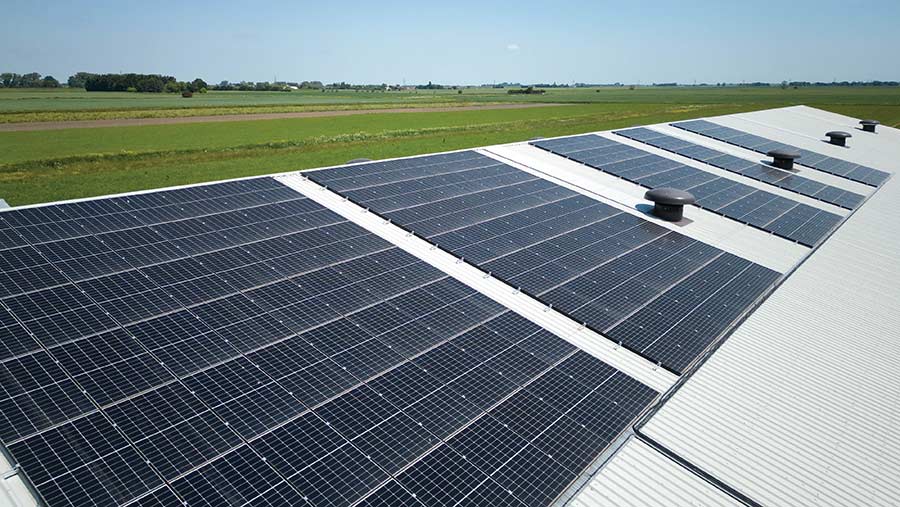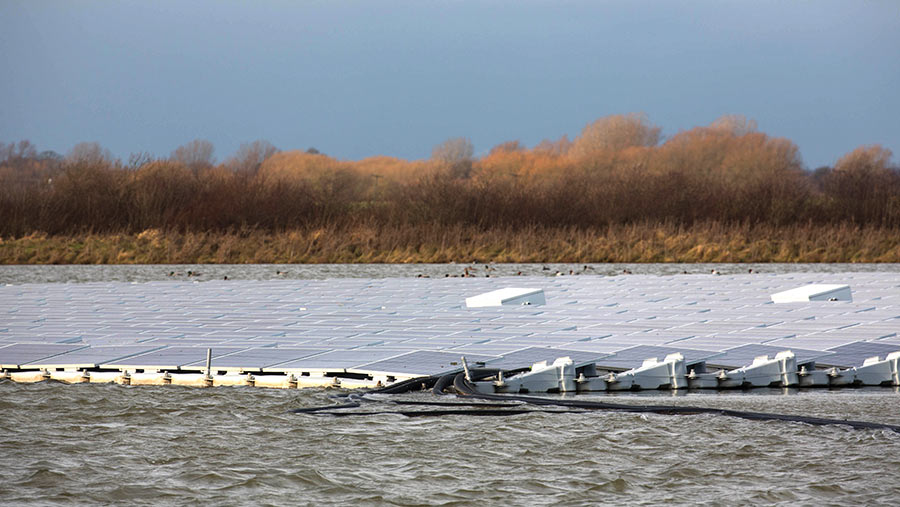Solar grants for farm projects – what’s covered and how to apply
 © Tim Scrivener
© Tim Scrivener The Improving Farm Productivity solar grant is designed to support the installation of solar equipment on farm roofs and reservoirs.
It is part of Defra’s drive to improve energy resilience and encourage electrification in agriculture.
However, the focus is not simply on subsidising new solar panels, points out the NFU’s chief renewable energy and climate change adviser Dr Jonathan Scurlock.
“Given higher electricity costs, the business case for solar without support has improved on many farms,” he says.
“Barriers to deployment are often more around available grid capacity, which is why the NFU worked hard with Defra to ensure the scheme includes funding towards equipment that can help farmers maximise on-site use and reduce the amount going into the grid.”
See also: Business Clinic: How can we check out battery storage offer
A dairy farm with an ice builder, for example, might be able to install reverse power relays and power diverters, so solar-generated electricity can charge the thermal store during the day, rather than exporting that power to the grid.
This could allow a larger rooftop array to be installed than might otherwise have been possible given limited grid capacity, says Jonathan.
What the grant covers
The Improving Farm Productivity (IFP) solar grant covers 25% of the capital cost for a wide range of equipment, including:
- Solar PV panels
- Battery storage
- Inverters
- Utility meters
- Electrical grid connections
- Power diverters
- Installation and commissioning of eligible items
- Alterations to the electrical supply within the holding to accommodate new solar equipment, for example, additional wiring from the distribution board
- Upgrades to electricity supply (up to 10% of the project’s total eligible costs)
- Installation of charging points.
PV panels can only be installed on farm building rooftops or irrigation reservoirs; ground-mounted systems are not eligible.

© Tim Scrivener
How much funding is available?
Grants range from £15,000 to £100,000. The £10,000 minimum funding is equivalent to 25% of a £60,000 system (roughly a 40kW array with some battery storage).
Mole Energy director David Stevenson says a ballpark fully installed price for rooftop solar is currently about £1,000/kW of generation capacity, although the cost may be higher or lower depending on project complexity.
Farmers must cover remaining project costs themselves through loans, overdrafts, or other sources, but not from other public money – for example, local authority grants.
It is possible to apply for both a solar grant and a farm productivity grant, but separate applications must be submitted, and the maximum grant across both applications is £500,000.
How to apply
Applications should be made through the Rural Payments Agency (RPA).
The IFP grant is competitive, with applications judged on how well they meet funding criteria.
There is a two-stage application process. Stage one is an online checker, which lets farmers enter basic details to see if they are eligible and how well their project fits funding priorities.
This is only open until 21 March, after which successful applicants will be invited to submit a full application.
David Stevenson says experience with running some applications through the online checker for farmers indicates that smaller-scale (sub-100kW) rooftop systems – with additional battery storage – on smaller farms appear to have a higher likelihood of being successful.
He advises farmers, particularly those with projects judged to have a lower likelihood of being awarded grant funding, to be aware of the timeframe between the initial eligibility check and confirmation.
The RPA aims to give a decision within 60 working days of receiving a full application, although at present no date has been set for when stage two applications will open.
“Solar pricing is quite competitive at the moment, so there’s potentially a risk that you wait for a grant, it isn’t successful, and equipment costs increase in the meantime.”
While the grant funding is welcome, he says any investment decision must be right for the farm.
Proper feasibility analysis should be done at the outset, considering factors such as physical roof space and building quality, budget, grid connectivity, finance and planning – although the latter is more of an issue for ground-mount systems.
Mole Energy offers a free feasibility service for farmers, which will also consider grant funding.
Find out more
For more information about the IFP solar grant, visit the gov.uk website
